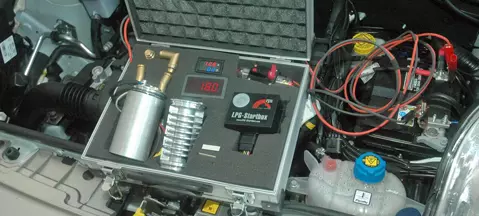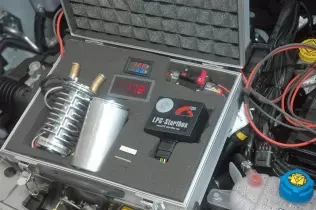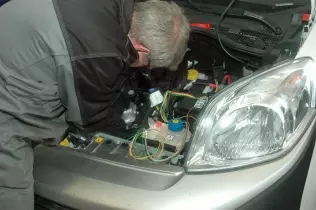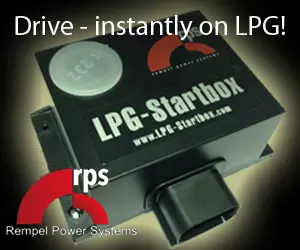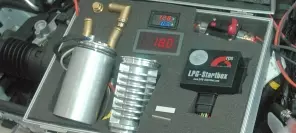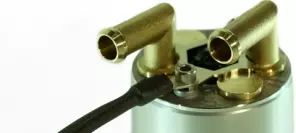- Main page
- Search
- Up to date
- Products
- Technology
- Vehicles
- Video
- Conversion Payback Simulator
Port Injection - Conversion Payback Simulator
Direct Injection - Conversion Payback Simulator
Diesel - Newsletter
LPG Startbox and Powerheater tried and tested
- Home page
- Up to date
- Reportages, interviews, road tests
- Road tests
- LPG Startbox and Powerheater tried and tested
« Powrót
 loading results...
loading results...Let's begin with painting the big picture here, which is the motivation behind creating the LPG Startbox (an electronic module sending the autogas system ECU a signal of the LPG reducer's optimal temperature, thus enabling switching over to autogas mode earlier) and the Powerheater (an electric LPG heater, which further cuts engine warmup time). The inventor of both, Viktor Rempel, founder of Rempel Power Systems, has been in the conversion business for years and heard voices of customers complaining about having to use too much petrol even though their cars feature LPG systems. Herr Rempel knows this problem first-hand, too – on colder days his car covers some 3 km before it switches over, so if he uses it on a home-school-work-shopping-home basis, he drives on petrol more often than not. It inspired him to build an additional system, which we hereby present as tested on two cars – a 2004 Chevrolet Rezzo 2,0 and a 2016 Fiat Fiorino 1,4.
But before we get to the results, we'll tell you a few words regarding the fitting procedure. It's a rather non-invasive operation, requiring soldering a few wires into the autogas system's ECU's electric harness and connecting the electric heater into the low-pressure LPG hose between the reducer and the injector rail. It all takes up to 2 hours of a single person's work and, should need arise, the petrol-saving set is easy to dismantle and move to another car, e.g. before selling one and buying another. Alternatively, you can leave the Startbox/Powerheater set in the car you're about to sell and use it to make your offer stand out. The thing is, once you experience the benefits it offers, you won't be very willing to give up on it.
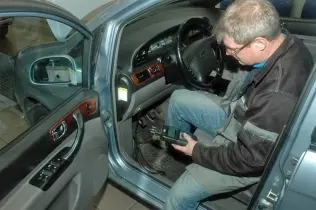 © gazeo.comFinding the engine temperature sensor signal is the first, but crucial phase of fitting the components
© gazeo.comFinding the engine temperature sensor signal is the first, but crucial phase of fitting the componentsFitting starts with locating the engine temperature sensor. Depending on the unit, there may be more than one, so it's vital to find the one mounted in the engine block – when it's disconnected, a scanner connected into the car's diagnostic socket should communicate -40° C temperature. The sensor's signal will be used by the LPG Startbox to determine the early switchover point. The Startbox also uses signals from the coolant temperature sensor, the reducer's solenoid valve (thus allowing to open it earlier than normally), the reducer's temperature and the injector rail's sensors (opening on cylinder one). The module also generates a signal of its own to control the Powerheater's relay. No wires need to be cut – it's enough to solder the Startbox's lines in. The module can also be disconnected from its socket and completely removed – without it, the autogas system works as usual, as if the additional components were never there.
Depending on ambient conditions and the engine's switchover smoothness once the Startbox and the Powerheater become operational, settings can be adjusted by switches inside the Startbox' housing. It can be programmed to allow the Powerheater to work constantly, even when the engine warms up (it then acts like an additional reducer, preventing efficiency drops under load) or just until the engine reaches optimal temperature. Whichever the case, the Powerheater starts warming up once the key is turned into ignition, cutting time necessary to switch over to as little as a few seconds, even at sub-zero ambient temperatures. For best effect it's possible to turn the key into ignition and wait 20-30 seconds before actually starting the engine. The Powerheater's warmup time is also regulated between 3 and 25 s after turning on the ignition, so you can choose the right one depending on the condition of your battery (the heater consumes lots of electricity, but we'll come to that later).
So much for theory, now let's get down to the practical test of RPS' petrol-saving combo. We divided it into three parts: one without the Startbox/Powerheater on (to determine just how much petrol the cars actually need for warmups), one with just the Startbox active and the final one with the Powerheater also on. In phase one, at ambient temperatures ranging from -5 to +5° C, the Rezzo needed some 4,5-5 minutes to switch over to LPG, covering from 800 m to 1,5 km on petrol, depending on traffic conditions. With 3-4 startups per days (including two cold ones, after lengthy stops), the Chevy consumed on average 0,45 l of petrol per day. That's quite a lot (especially that the car is primarily used for commuting and covers less than 20 km per day) and we bet many users of LPG-powered cars don't realise how much petrol their cars need, because they never refilled them with petrol and checked. 0,45 l of petrol daily is over 13 l monthly, which means spending some tangible money, probably an equivalent of a single LPG refill.
As for the Fiorino, it needed anything from 5 to even 11 minutes to warm up and switch over (even minor drops of ambient temperature affect it considerably) and given the purpose it serves, it was started up to 10 times daily. All this resulted in petrol consumption of 0,82 l per day, which is 25 l per month. The cost of such an amount of petrol is higher than a single autogas refill. But mind you, actual savings from using the Startbox/Powerheater duo are smaller, because you need to replace warmup petrol with autogas. Effectively, it's like cutting monthly petrol consumption by 6,5 and 12,5 l, respectively.
In phase two, with only the Startbox on, the Chevrolet switched over to LPG after exactly 54 s from startup, irrespective of temperature outside. Usually that was even before the car moved from its parking spot. Switchovers became slightly rougher (there was a moment of choking), but the engine never stalled. And since warmup time was reduced four-fold, we expected petrol consumption to follow suit. We were right – daily portions were reduced to 0,11 l, with no changes to the way the car was used. Fiorino behaved similarly, with petrol use reduced to 0,15 l daily (with warmup time of just 8 s on average). Relatively speaking, the small delivery Fiat reduced its petrol consumption more than the Rezzo – it needed more than five times less. That's very good already and don't forget there's phase three – potentially the most interesting one – still waiting ahead!

with the Powerheater on? And when
does it all pay back? Head past the break!
Left: 50%
You may also find these interesting:
 loading results...
loading results...
